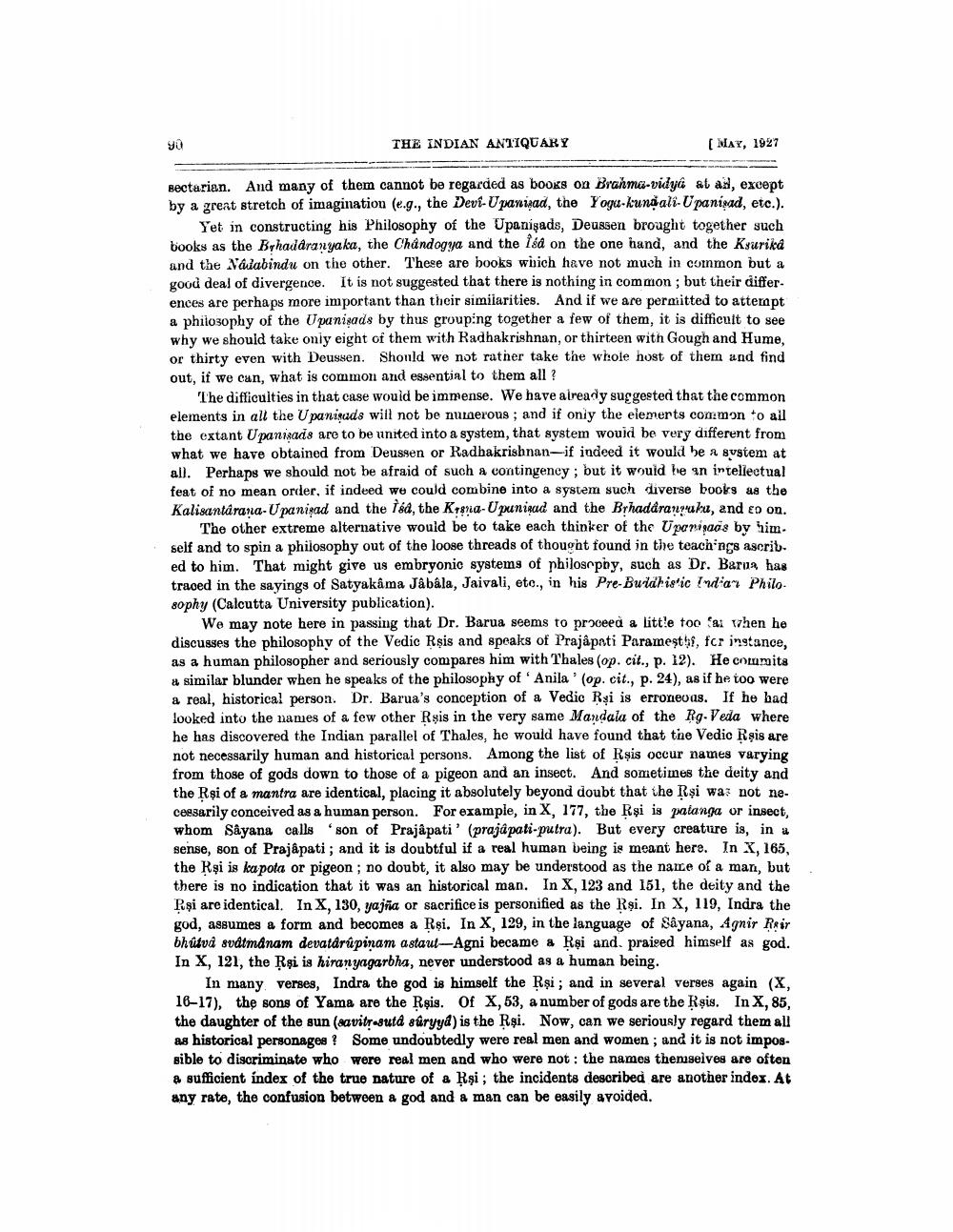________________
90
THE INDIAN ANTIQUARY
[ MAY, 1927
sectarian. And many of them cannot be regarded as books on Brahma-vidya at all, except by a great stretch of imagination (e.g., the Devi-Upanisad, the Yoga-kundali-Upanisad, etc.). Yet in constructing his Philosophy of the Upanisads, Deussen brought together such books as the Brhadaranyaka, the Chandogya and the lid on the one hand, and the Ksurika and the Nadabindu on the other. These are books which have not much in common but a good deal of divergence. It is not suggested that there is nothing in common; but their differences are perhaps more important than their similarities. And if we are permitted to attempt a philosophy of the Upanisads by thus grouping together a few of them, it is difficult to see why we should take only eight of them with Radhakrishnan, or thirteen with Gough and Hume, or thirty even with Deussen. Should we not rather take the whole host of them and find out, if we can, what is common and essential to them all?
The difficulties in that case would be immense. We have already suggested that the common elements in all the Upanisads will not be numerous; and if only the elements common to all the extant Upanisads are to be united into a system, that system would be very different from what we have obtained from Deussen or Radhakrishnan-if indeed it would be a system at all. Perhaps we should not be afraid of such a contingency; but it would be an intellectual feat of no mean order, if indeed we could combine into a system such diverse books as the Kalisantarana-Upanisad and the Isd, the Krana-Upanisad and the Bṛhadaranyaku, and so on.
The other extreme alternative would be to take each thinker of the Upariaas by him. self and to spin a philosophy out of the loose threads of thought found in the teachings ascribed to him. That might give us embryonic systems of philosophy, such as Dr. Barua has traced in the sayings of Satyakâma Jâbâla, Jaivali, etc., in his Pre-Buddhistic Indian Philo sophy (Calcutta University publication).
We may note here in passing that Dr. Barua seems to proceed a little too fai when he discusses the philosophy of the Vedic Rsis and speaks of Prajapati Parameşti, for instance, as a human philosopher and seriously compares him with Thales (op. cit., p. 12). He commits a similar blunder when he speaks of the philosophy of Anila' (op. cit., p. 24), as if he too were a real, historical person. Dr. Barua's conception of a Vedic Ṛşi is erroneous. If he had looked into the names of a few other Rṣis in the very same Mandala of the Rg. Veda where he has discovered the Indian parallel of Thales, he would have found that the Vedic Rṣis are not necessarily human and historical persons. Among the list of Rsis occur names varying from those of gods down to those of a pigeon and an insect. And sometimes the deity and the Ṛsi of a mantra are identical, placing it absolutely beyond doubt that the Rși was not necessarily conceived as a human person. For example, in X, 177, the Rsi is patanga or insect, whom Sâyana calls son of Prajapati' (prajapati-putra). But every creature is, in a sense, son of Prajapati; and it is doubtful if a real human being is meant here. In X, 165, the Rși is kapota or pigeon; no doubt, it also may be understood as the name of a man, but there is no indication that it was an historical man. In X, 123 and 151, the deity and the Rşi are identical. In X, 130, yajña or sacrifice is personified as the Rși. In X, 119, Indra the god, assumes a form and becomes a Rsi. In X, 129, in the language of Sâyana, Agnir Reir bhûtva svátmânam devatárupinam astaut-Agni became a Rși and. praised himself as god. In X, 121, the Ṛsi is hiranyagarbha, never understood as a human being.
In many verses, Indra the god is himself the Rşi; and in several verses again (X, 16-17), the sons of Yama are the Rsis. Of X, 53, a number of gods are the Ṛsis. In X, 85, the daughter of the sun (savitṛ-sutd sûryyd) is the Rşi. Now, can we seriously regard them all as historical personages? Some undoubtedly were real men and women; and it is not impossible to discriminate who were real men and who were not: the names themselves are often a sufficient index of the true nature of a Rşi; the incidents described are another index. At any rate, the confusion between a god and a man can be easily avoided.




